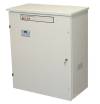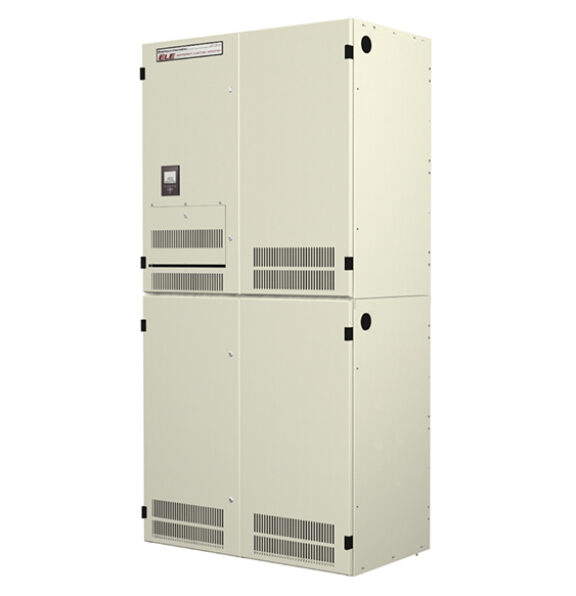Our team is here to support you and solve your power challenges. Connect with our responsive experts today to learn about our customized power solutions and products.
eLITE Model ELN (550W -1.5kW)
Meeting the NFPA 101 and NFPA 111 standards, the eLITE Model ELN is considered “Life Safety Equipment.” The Model ELN is also UL 924 listed as “Emergency Lighting Equipment,” providing the required 90 minutes of emergency backup power. With a front-access design and a small footprint, the Model ELN is suited for wall- or floor-mounted installations.
The Model ELN is compatible with LED drivers/fixtures, and is a perfect choice when providing emergency power to fan motor loads that are a part of the life safety system.
Single Phase Sizes: 550W, 1kW, 1.5kW
Applications
- Schools
- Gymnasiums/Athletic Fields
- Indoor/Outdoor Security Lighting
- Outdoor Egress
- Security Systems
- Parking Structures/Garages
- Hospitals/Clinics
- Shopping Centers/Strip Malls
- Banks/Financial Institutions
- Worship Facilities
- Restaurants
- Theaters
- Hotels/Motels

Product Specifications
Features and Benefits
- Listed UL 924 “Emergency Lighting Equipment” and “Auxiliary Lighting and Power Equipment”
- Meets NFPA 101 and NFPA 111 standards, including SEPSS (Stored Electrical Energy Emergency and Standby Power Systems)
- Uninterrupted, regulated, continuous sine wave output for use with “Normally On” lighting fixtures and exit lamps
- Standby output for use with “Normally Off” lighting fixtures
- Programmable, timed “Normally Off” and “Normally On” outputs
- Integral constant voltage transformer isolates and regulates output voltage
- True no-break system, providing voltage regulation and performance characteristics that extend ballast, LED driver, and lamp life
- System approved for 42k AIC rated source
- Integral status and alarm panel
- Front-access design and small footprint are ideal for wall- or floor-mounted installations
- Standard NEMA 2 drip-proof enclosure
- Remote communications via alarm signals or RS232
- Generator-compatible
- Optional remote status panel
- Optional NetMinder Ethernet/MODBUS adapter for network monitoring
Performance Specs
- Input Operating Voltage Range: +10%, -40% typical, load-dependent, without battery usage
- Input Frequency: 60 Hz, ± 2.5%
- Output Sine Wave Voltage: Maximum 3% harmonic distortion, any single harmonic
- Power Factor: Self-correcting to >0.95
- Line Voltage Regulation: ± 3%
- Load Regulation: Typically better than ±3%
- Isolation: Galvanic
- Standard Unit Operating Temperature: 0°C to +40°C
- Total System MTBF: 100,000 hours
- Common Mode Noise Rejection: 120 dB
- Transverse Mode Noise Rejection: 70 dB
- Efficiency: 89% typical
Frequently Asked Questions
What is a lighting inverter?
A lighting inverter is an electronic system that converts DC battery power to standard AC voltages to provide back-up for emergency lighting systems. This inverter provides convenient emergency power for all types of lighting fixtures, increasing its usability.
Why use centralized lighting inverters?
Centralized lighting inverters provide a single point source of power for all emergency lighting and exit signs. This allows for a convenient point of maintenance and provides for a controlled, logical wiring scheme. The output of the inverter is fed to a dedicated lighting panel, which provides power exclusively for the emergency lighting system.
Is there a difference in lighting inverters?
Yes! Lighting inverters differ in switch time, voltage regulation, and power conditioning. The standards for emergency lighting inverters are defined in the UL 924 test procedures. These procedures omit the difference in characteristics. Some inverters may take up to 1 to 2 seconds to respond to a power outage, while others provide a seamless transfer. The seamless transfer systems provide the kind of power necessary for sensitive electronic lighting, HID fixtures, lighting controls, and alarm circuits.
How important is the transfer time?
Transfer time is the time it takes to recognize and deliver emergency power. An inverter providing zero transfer time ensures that there is no interruption of power to the emergency lighting fixtures. Lighting control systems and alarm circuits may also need a no-break type system because of the circuit power requirements.
Should lighting inverters include voltage regulation and power conditioning?
Yes. Voltage regulation ensures that voltage drops and brownouts do not affect the overall lighting system. Voltage regulation also ensures proper lighting levels during normal operating conditions in “Normally On” circuits. Power conditioning prevents voltage surges and transients from reaching the electronic ballasts and/or LED drivers, thus providing longer life of the lighting fixture.
Can any UPS (battery backup) be used for emergency lighting?
No. Emergency lighting systems are governed by UL 924 standards. Only lighting inverters that have been tested and certified to this standard can be used.


